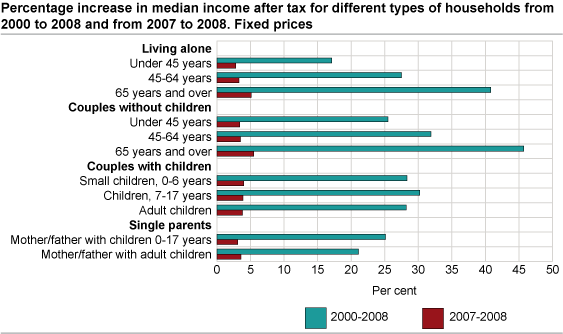Content
Published:
This is an archived release.
Solid income growth for most households
Norwegian households’ after-tax income rose by 3.4 per cent from 2007 to 2008 in fixed prices. Elderly households, both singles and couples, enjoyed the strongest rise in income, while young singles had the weakest income growth.
Median income after tax rose by 3.4 per cent for Norwegian private households from 2007 to 2008 measured in fixed prices. Most households enjoyed a growth in their income, but some types of households increased their income more than others. Elderly households, both singles and couples, enjoyed the strongest real growth in median income by 5 per cent, while young singles (younger than 45) had the weakest income growth by less than 3 per cent from 2007 to 2008.
The elderly have been the ”income winners” in recent years, while young single households for several years have experienced an income growth less than the general rise in household income. Since the beginning of the century, median income after tax among young singles has risen by 17 per cent in fixed prices. The equivalent rise in income among singles aged 65 and older was 41 per cent, while couples in the same age group increased their income by 46 per cent from 2000 to 2008. Private households in total increased their median income after tax by almost 34 per cent in this period, measured in fixed prices.
The strong increase in income among the elderly can be explained by favourable pension settlements, and by the fact that new old-age pensioners to a larger extent receive earnings-related public pensions than older pensioners. In addition, service pensions, received interest and income from work have become more important for the elderly in recent years.
A larger proportion of immigrants among young singles partly explain the relatively weak growth in income among these households. From 2005 to 2008, the proportion of immigrants increased from 15 to 21 per cent among the youngest singles (age below 30). Among young single immigrants in 2008, more than one third immigrated to Norway the same year. Thus, many of them will not have earned a full-year-income.
Tables:
Contact
-
Jon Epland
E-mail: jon.epland@ssb.no
tel.: (+47) 92 61 69 08
-
Elisabeth Løyland Omholt
E-mail: elisabeth.omholt@ssb.no
tel.: (+47) 93 05 55 28
-
Christian Brovold
E-mail: christian.brovold@ssb.no
tel.: (+47) 91 75 31 32
-
Lene Sandvik
E-mail: lene.sandvik@ssb.no
tel.: (+47) 90 13 16 16

